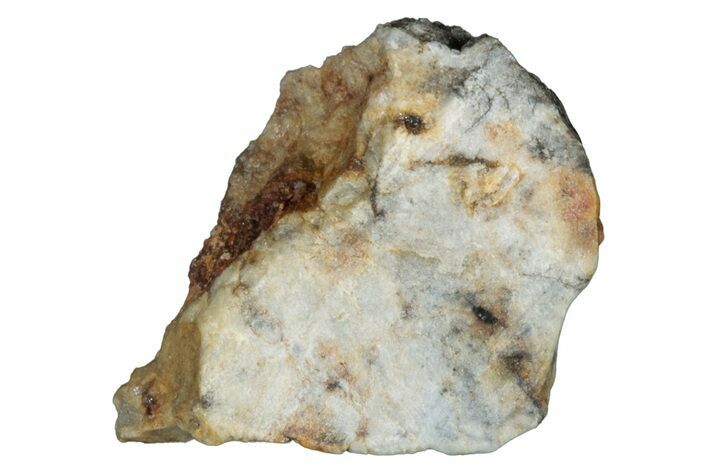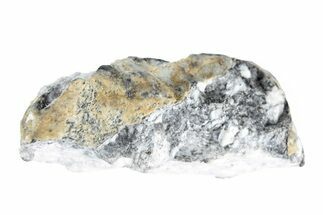This Specimen has been sold.
.45" Aubrite Meteorite Slice - Djoua 001
This is a small, .45" wide slice of the meteorite known as Djoua 001, an unusual kind of achondrite called an aubrite. They are meteorites made of entstatite in igneous and impact-melted clasts that likely come from E-type asteroids.
It comes in an acrylic display case.
It comes in an acrylic display case.
About Djoua 001 Meteorite
Djoua 001 is the name given to the scattered pieces of a meteorite found in February and March of 2021 near Illizi, Algeria. Since its discovery, about 22.5 kilograms of material have been recovered.
Djoua 001 is an aubrite, an achodrite meteorite composed primarily of enstatite. It displays a relatively pale coloration, with a black coating in places that may be degraded fusion crust. The interior features mottled beiges and grays interrupted by dark and rusty spots, and rarely displaying small metallic grains.
Meteoritical Bulletin Entry: Djoua 001 Meteorite
Djoua 001 is the name given to the scattered pieces of a meteorite found in February and March of 2021 near Illizi, Algeria. Since its discovery, about 22.5 kilograms of material have been recovered.
Djoua 001 is an aubrite, an achodrite meteorite composed primarily of enstatite. It displays a relatively pale coloration, with a black coating in places that may be degraded fusion crust. The interior features mottled beiges and grays interrupted by dark and rusty spots, and rarely displaying small metallic grains.
Meteoritical Bulletin Entry: Djoua 001 Meteorite
About Aubrites
Aubrites are a unique class of achondritic meteorites that represent some quite extreme formation conditions in the early solar system. Aubrites are almost all breccias consisting of whitish enstatite, with occasional inclusions of olivines, nickel-iron, and troilite, along with impact-melted clasts seen in achondrites.
Enstatite is a form of orthopyroxene that forms in igneous conditions and is considered an early stage of mineral formation in the solar system. Enstatite meteorites likely originate from E-type (enstatite-rich) asteroids close to the sun, particularly the near-Earth object 3130-Eger. It has even been observed outside of the solar system around evolved stars and planetary nebulae!
Aubrites are a unique class of achondritic meteorites that represent some quite extreme formation conditions in the early solar system. Aubrites are almost all breccias consisting of whitish enstatite, with occasional inclusions of olivines, nickel-iron, and troilite, along with impact-melted clasts seen in achondrites.
Enstatite is a form of orthopyroxene that forms in igneous conditions and is considered an early stage of mineral formation in the solar system. Enstatite meteorites likely originate from E-type (enstatite-rich) asteroids close to the sun, particularly the near-Earth object 3130-Eger. It has even been observed outside of the solar system around evolved stars and planetary nebulae!
About Achondrites
Achondrites are a type of stony meteorite that lacks chondrules--round grains that aggregate from molten or partially molten droplets in space to form chondrites. Achondrites still contain grains, but their textures are extremely distinct and analogous with igneous processes rather than the chondrule-producing conditions at the beginning of the solar system.
Achondrites make up about 8 percent of all known meteorites. They are almost all regolith breccias, ejected from impacts on larger asteroids and sometimes the moon and Mars. Most are HED (howardite-eucrite-diogenite) in composition, sourced from the asteroid Vesta: it is the second largest asteroid in the Solar System and the only asteroid visible to the naked eye.
Achondrites are a type of stony meteorite that lacks chondrules--round grains that aggregate from molten or partially molten droplets in space to form chondrites. Achondrites still contain grains, but their textures are extremely distinct and analogous with igneous processes rather than the chondrule-producing conditions at the beginning of the solar system.
Achondrites make up about 8 percent of all known meteorites. They are almost all regolith breccias, ejected from impacts on larger asteroids and sometimes the moon and Mars. Most are HED (howardite-eucrite-diogenite) in composition, sourced from the asteroid Vesta: it is the second largest asteroid in the Solar System and the only asteroid visible to the naked eye.
TYPE
Enstatite Achondrite (Aubrite)
AGE
LOCATION
Illizi, Algeria, Africa
SIZE
.45 x .31 x .10"
CATEGORY
SUB CATEGORY
ITEM
#283662
 Reviews
Reviews












